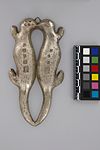Kissing Otter Pendant
About this object
History of use
Initially, the main sources of silver were British, French, and Spanish coins. Most ornaments were produced by silversmiths of European origin in North America and Europe. By the mid-18th century silver objects were produced in New England, Quebec and Montreal. Silver ornaments continue to be produced by native silversmiths in Central Canada and the USA. Animal imagery is a significant part of Woodland First Nations tradition, but no documented instance has been found of the use of animal effigies in trade. The place of effigies in Woodlands culture is not known.
In 1670 King Charles II of England granted an exclusive fur trading charter to the Hudson's Bay Company in what was later to become Canada. The company's mandate was to protect the crown's interests and undertake exploration and territorial expansion. Competition for furs was intense, and in 1784 the North West Company was formed by a number of independent trading groups. By 1821 this company faced bankruptcy and merged with the Hudson's Bay Company. This latter company still exists today, operating a number of retail stores across Canada, and is known simply as The Bay.
Cultural context
personal ornamentation
Physical description
A pair of hollow silver otters joined at mouth, back and tail. There are engraved lines on the otters and stamped eyes, nose and eyebrows. A loop is soldered between the mouths. A cartouche with makers' marks is stamped on the back of both otters.
Date Made
1752-1821
Date Acquired
9 Sep 1993
How Acquired
Donated
Credit Line
Measurements
1 x 16 x 8 cm
Object Number
1590/8
